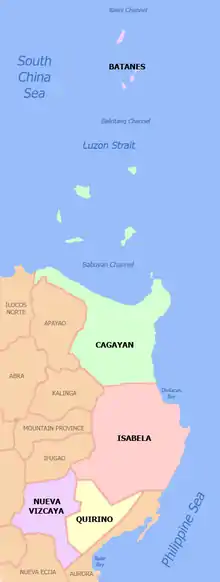Isabela (province)
Isabela, officially the Province of Isabela (Ilocano: Probinsia ti Isabela; Ibanag: Provinsia na Isabela; Tagalog: Lalawigan ng Isabela) is the second largest province in the Philippines in land area located in the Cagayan Valley region. Its capital and the largest local government unit is the city of Ilagan. It is bordered by the provinces of Cagayan to the north, Kalinga to the northwest, Mountain Province to the central-west, Ifugao and Nueva Vizcaya to the southwest, Quirino and Aurora to the south, and the Philippine Sea to the east.
Isabela | |
|---|---|
| Province of Isabela[1] | |
_-_ZooKeys-266-001-g003.jpg.webp) 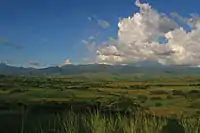     (from top: left to right) Pacific coast in Dinapigue, Sierra Madre Mountains, Magat Dam, Cagayan River in Jones, Aerial view of Divilacan and Cabigan Church Ruins in San Pablo. | |
.svg.png.webp) Flag  Seal | |
Nicknames:
| |
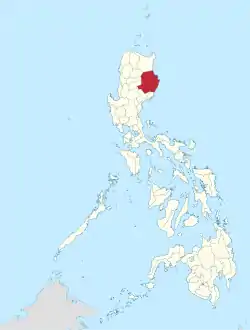 Location in the Philippines | |
OpenStreetMap  | |
| Coordinates: 17°N 122°E | |
| Country | Philippines |
| Region | Cagayan Valley |
| Founded | May 01, 1856 |
| Capital and largest city | Ilagan |
| Government | |
| • Type | Sangguniang Panlalawigan |
| • Governor | Rodolfo T. Albano III (PDP–Laban) |
| • Vice Governor | Faustino Dy III(NPC) |
| • Legislature | Isabela Provincial Board |
| Area | |
| • Total | 12,414.93 km2 (4,793.43 sq mi) |
| • Rank | 2nd out of 81 |
| (includes Santiago) | |
| Highest elevation | 1,736 m (5,696 ft) |
| Population | |
| • Total | 1,697,050 |
| • Rank | 15th out of 81 |
| • Density | 140/km2 (350/sq mi) |
| • Rank | 67th out of 81 |
| (Includes Santiago) | |
| Demonyms |
|
| Divisions | |
| • Independent cities | 1
|
| • Component cities | 2
|
| • Municipalities | 34
|
| • Barangays |
|
| • Districts | Legislative districts of Isabela (shared with Santiago City) |
| Time zone | UTC+8 (PHT) |
| ZIP code | 3300–3336 |
| IDD : area code | +63 (0)78 |
| ISO 3166 code | PH-ISA |
| Spoken languages | |
| Website | provinceofisabela |
This primarily agricultural province is the rice and corn granary of Luzon due to its plain and rolling terrain. In 2012, the province was declared as the country's top producer of corn with 1,209,524 metric tons.[7] Isabela was also declared the second-largest rice producer in the Philippines and the Queen Province of the North.[8][9][10]
Isabela is the 10th richest province in the Philippines as of 2011.[11] The province has four trade centers in the cities of Ilagan, Cauayan, Santiago and the municipality of Roxas. Santiago City is considered to have the fastest-growing local economy in the entire Philippines.[12]
Etymology
The province was named after Isabella II, who was queen regnant of Spain from 29 September 1833 until 30 September 1868, when she was deposed in the Glorious Revolution, and her formal abdication two years later.
There have been proposals to change the name to something more indigenous, but these were rejected by the people of Isabela.
History
The province of Isabela used to be a vast rainforest where numerous indigenous ethnolinguistic groups lived. Many of the same ethnic groups still live in the province. Shell midden sites and other archaeological sites throughout the province constitute the material culture of those groups during the classical era.
Spanish colonial period
During the Spanish era, prior to 1856, the Cagayan Valley was divided into only two provinces: Cagayan and Nueva Vizcaya. The Province of Cagayan at that time consisted of all towns from Tumauini to Aparri in the north. All other towns from Ilagan southward to Aritao comprised the Province of the old Nueva Vizcaya. In order to facilitate the work of the Catholic missionaries in the evangelization of the Cagayan Valley, a royal decree was issued on May 1, 1856, creating the Province of Isabela consisting of the towns of Gamu, Old Angadanan (now Alicia), Bindang (now Roxas) and Camarag (now Echague), Carig (now Santiago City) and Palanan, all detached from the Province of Nueva Vizcaya; while Cabagan and Tumauini were taken from the Province of Cagayan.
The province was placed under the jurisdiction of a governor (Lieutenant Colonel of Cavalry Francisco Contreras y Urtasun) with Ilagan as the capital, where it remains up to present. It was initially called Isabela de Luzón to differentiate from other places in the Philippines bearing the name of Isabela. The new province was named after Queen Isabella II of Spain.[13]
American era
Although the province did not play a major role in the revolt against Spain, it is in Palanan that the final pages of the Philippine Revolution were written when United States troops, led by General Frederick Funston, finally captured General Emilio Aguinaldo in the area on March 23, 1901. To commemorate this historical event, Dr. Philip S. Chua, MD, FACS, FPCS (now a cardiac surgeon in Las Vegas, Nevada, and Munster, Indiana, USA) then a 26-year-old medical missionary volunteer to the Work-A-Year-With-The-People's project of then Senator Raul S. Manglapus, Manuel Quezon, Jr., and Ramon Magsaysay, Jr., in 1962, while ministering to the health needs of the people in Palanan in his medical office at the Carmelite Convent, succeeded in convincing the town officials to construct a marker, a monument by the Palanan City Hall, right on the spot where General Aguinaldo was captured, to memorialize the historical event. The monument was inaugurated on June 12, 1962, Philippine Independence Day, and still stands today.
Isabela was re-organized as a province under the American military government through Act No. 210, passed August 24, 1901.[14]
The Americans built schools and other buildings and instituted changes in the overall political system. However, the province's economy remained particularly agricultural with rice replacing corn and tobacco as the dominant crop. World War II stagnated the province's economic growth but it recovered dramatically after the war. In 1942, Imperial Japanese occupied Isabela. In 1945, the liberation of Isabela commenced with the arrival of the Philippine Commonwealth troops under the Philippine Army, Constabulary, and USAFIP-NL units and recognized guerrillas attacked by the Japanese Imperial forces in World War II.
A new wave of immigration began in the late 19th and 20th centuries with the arrival of the Ilokano who came in large numbers. They now constitute the largest group in the province. Other ethnic groups followed that made Isabela the "Melting Pot of the Northern Philippines".[13]
Independent era
In 1975, construction began on the Magat Dam on the boundary of Ramon, Isabela with neighboring Ifugao Province, becoming a catchbasin for 8 rivers upstream in Ifugao[15] and serving multiple functions, including: irrigating of agricultural lands; flood control; and power generation. The construction was protested by the Ifugao people due to the flooding of their ancestral lands,[16] but the dam was eventually completed in 1982, partially funded through a loan from the World Bank.[17]
In 1995, Republic Act 7891 was passed, legislating that Isabela be divided into two new provinces: Isabela del Norte and Isabela del Sur.[18][19] A referendum was held on the same year with a slight majority voting against partitioning the province.[20]
In 2012, the capital town of Ilagan officially became a city, after the move gained 96% of the votes in the plebiscite conducted on August 11, 2012.[21][22] The night after the plebiscite, Ilagan was declared as a component city of the province.[23]
Geography
Isabela comprises an aggregate land area of 12,414.93 square kilometres (4,793.43 sq mi),[24] representing almost 40 percent of the regional territory. It is the largest province in the island of Luzon and the second largest province in the Philippines by land area. Occupying the central section of the Cagayan Valley region in Luzon, Isabela is bordered by Cagayan to the north, Kalinga to the northwest, Mountain Province to the central-west, Ifugao and Nueva Vizcaya to the southwest, Quirino to the south, and Aurora to the south. To the east lies the Philippine Sea, making Isabela one of the typhoon-prone provinces in the country.

The province is divided into three physiographic areas. The eastern area, straddled by the Sierra Madre mountain range, is rugged and thickly forested. A substantial portion is uncharted. These unexplored hinterlands are home to a rich variety of flora and fauna, and some are under government reservations. It is home to one of the world's largest remaining low-altitude rainforests, with numerous unknown endemic species of flora and fauna and biological diversity in the protected area known as the Northern Sierra Madre Natural Park. Isabela has 600,000 hectares (1,500,000 acres) of Cagayan Valley’s 900,000 hectares (2,200,000 acres) of forest cover.[25][26]
The highest point of the province is located near the border with Cagayan. Mount Dos Cuernos peak has an elevation of 1,785 metres (5,856 ft) located in San Pablo near the border with Maconacon. Other notable peaks in the Northern Sierra Madre Natural Park is Mount Cresta in Divilacan with an elevation of 1,672 metres (5,486 ft).[27]
The western area is a fertile valley hemmed by the Central Cordillera. It is crisscrossed by the mighty Cagayan River, Siffu River, and Magat River.
Mallig Plains region
Mallig Plains is a region in the western section of the province. Its name was derived from the rolling terrains or kilometers of plain lands in western part of Isabela. The municipality of Roxas serves as the business center of the region. The Plains encompassing the municipalities of Quezon, Mallig, Quirino, Burgos, Aurora, San Manuel and Roxas.
Administrative divisions
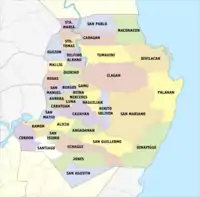
Isabela is politically subdivided into thirty-four (34) municipalities, two component cities and one independent component city. The province is represented in the Philippine House of Representatives with six legislative districts.[24]
The province has ten first class municipalities, two second class cities and one first class independent component city. Ilagan City, which became a city thirteen years after its failed cityhood proposal in 1998, it is now Luzon’s largest and the country’s fourth biggest city after Davao City, Puerto Princesa and Zamboanga City by land area.
- † Provincial capital and component city
- ^ Independent component city
- ∗ Component city
- Municipality
| ||||||||||||||||||||||||||||||||||||||||||||||||||||||||||||||||||||||||||||||||||||||||||||||||||||||||||||||||||||||||||||||||||||||||||||||||||||||||||||||||||||||||||||||||||||||||||||||||||||||||||||||||||||||||||||||||||||||||||||||||||||||||||||||||||||||||||||||||||||||||||||||||||||||||||||||||||||||||||||||||||||||||||||||||||||||||||||||||||||||||||||||||||||||||||||||||||||||||||||||||||||||||||||||||||||||||||||||||||||||||||||||||||||||||||||||||||||||||||||||||||||||||||||||||||||||||||||||||||||||||||||||
Barangays
The 34 municipalities and 3 cities of the province comprise 1,055 barangays, with Rizal in Santiago City as the most populous in 2010, and Catalina in Cauayan City as the least. If cities are excluded, Bugallon Proper (Poblacion) in Ramon has the highest population, and Uauang-Tuliao in Santo Tomas has the lowest. [32]
Government
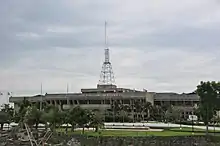
Governors
After Isabela was re-organized as a province under the American regime in 1901, its first provincial governor was Rafael Maramag, a former Municipal President and also the first Municipal President of the capital town Ilagan. He was succeeded by his brother, Gabriel. Afterwards, Isabela was ruled by the Dy family for 34 years (1969-2004). The dynasty was started by the patriarch of the family, Faustino N. Dy, Sr., who served as the Mayor of Cauayan from 1965 to 1969 and sat as the provincial governor of Isabela for 22 years (1969–1992).Around 1987, former mayor of Santiago, Mayor Dodo Miranda planned to run as governor of Isabela but was ambushed by an unidentified gunman in Reina Mercedes. The reason Santiago City is independent to Isabela was because of that incident. He was succeeded by his son, Benjamin G. Dy, in the gubernatorial seat from 1992 to 2001. Another Dy took over the gubernatorial seat in 2001 when Faustino Dy Jr. won the 2001 elections after having served as the district representative of the 2nd Legislative District of the province from 1992 to 2001. It was only in the 2004 elections that the family's control of the gubernatorial seat ended when Grace Padaca won over Faustino Dy Jr. She was the first woman to serve as the governor of the province. After serving for six years (2004-2010), she was defeated in the 2010 National Elections by Faustino "Bojie" G. Dy III who served as governor of the province for three consecutive terms (2010-2019).
| Position | Provincial Official |
|---|---|
| Provincial Governor | Rodolfo T. Albano III |
| Provincial Vice Governor | Faustino G. Dy III |
| District Representatives | Rep. Antonio T. Albano (1st District) |
| Rep. Ed Christopher S. Go (2nd District) | |
| Rep. Ian Paul L. Dy (3rd District) | |
| Rep. Sheena Alyssa T. Dy (4th District and Santiago City) | |
| Rep. Faustino Michael Carlos T. Dy III (5th District) | |
| Rep. Faustino A. Dy V (6th District) | |
| Provincial Board Members | Delfinito Emmanuel L. Albano (1st District) |
| Emmanuel Joselito B. Añes (1st District) | |
| Ed Christian S. Go (2nd District) | |
| Edgar R. Capuchino (2nd District) | |
| Ramon Juan N. Reyes (3rd District) | |
| Randolph Joseph P. Arreola (3rd District) | |
| Abegail V. Sable (4th District) | |
| Clifford R. Raspado (4th District) | |
| Faustino U. Dy IV (5th District) | |
| Edward S. Isidro (5th District) | |
| Marco Paolo A. Meris (6th District) | |
| Afredo V. Alili (6th District) |
Legislative districts
On September 27, 2018, Republic Act No. 11080, an act reapportioning the province of Isabela into six legislative districts from four, was signed into law and the reapportioned districts elected its representatives starting in the 2019 midterm elections.[33][34] Accordingly, the six districts[35] are as follows:
- First District: Cabagan, Delfin Albano, Divilacan, Ilagan City, Maconacon, San Pablo, Santa Maria, Santo Tomas and Tumauini.
- Second District: Benito Soliven, Gamu, Naguilian, Palanan, Reina Mercedes and San Mariano.
- Third District: Alicia, Angadanan, Cabatuan, Ramon and San Mateo.
- Fourth District: Cordon, Dinapigue, Jones, Santiago City and San Agustin.
- Fifth District: Aurora, Burgos, Luna, Mallig, Quezon, Quirino, Roxas and San Manuel.
- Sixth District: Cauayan City, Echague, San Guillermo and San Isidro.
Demographics
| Year | Pop. | ±% p.a. |
|---|---|---|
| 1903 | 76,431 | — |
| 1918 | 112,960 | +2.64% |
| 1939 | 219,864 | +3.22% |
| 1948 | 264,495 | +2.07% |
| 1960 | 442,062 | +4.37% |
| 1970 | 648,123 | +3.90% |
| 1975 | 730,386 | +2.43% |
| 1980 | 870,604 | +3.57% |
| 1990 | 1,080,341 | +2.18% |
| 1995 | 1,160,721 | +1.35% |
| 2000 | 1,287,575 | +2.25% |
| 2007 | 1,401,495 | +1.18% |
| 2010 | 1,489,645 | +2.24% |
| 2015 | 1,593,566 | +1.29% |
| 2020 | 1,697,050 | +1.24% |
| Source: Philippine Statistics Authority [29] [32] [36][37] | ||
The population of Isabela in the 2020 census was 1,697,050 people, [5] making it the most populated province among the five provinces in Cagayan Valley (Region II). It had a density of 140 inhabitants per square kilometre or 360 inhabitants per square mile.
In 2010, Isabela had a population of 1,489,645 people: 46 percent of the 3.2 million people in the region at that time. At the national level, the province contributed 1.58 percent to the total population of 88.57 million. There were 254,928 households in the province in 2007.
For all ages, the sex ratio in Isabela was about 105 with 660,627 males and 626,948 females in the 2000 Census of Population and Housing (Census 2000). There are more males than females below 50 years old.
Ilocanos are the most prominent group in the province. Of the total household population, 68.71 percent classified themselves as Ilocanos, followed by the Ibanags (14.05 percent), and Tagalogs (10.02 percent). The majority ethnic group were the Ibanags, who were first seen by the Spanish explorers and converted to Christianity by missionaries, the reason why the Ibanag language had spread throughout the valley region prior to the arrival of the migrating Ilocanos. The remaining 7.22 percent are either Gaddang, Paranan, Yogad, or from other ethnic groups who have assimilated into the Ibanag-Ilocano culture . More recently, a new group from the south, the Muslim Filipinos, have migrated to this province and have made a community for themselves. In addition to this, Tagalog-speaking peoples from Central Luzon (mostly from Nueva Ecija) and Southern Luzon have also settled in the area, as well as a few Pangasinans and Kapampangans from the Central Luzon.
Major languages spoken are Ilocano followed by Ibanag, Yogad, and Gaddang. Ilocanos and Ibanags speak Ilocano with an Ibanag accent, as descendants of Ilocanos from first generation in Isabela who lived within Ibanag population learned Ibanag; same situation with Ilocano tinged by Gaddang, Paranan, Yogad, and Itawis accents when descendants of Ilocanos from first generation in Isabela who lived within Gaddang, Paranan, Yogad, and Itawis populations learned their languages. People especially in the capital and commercial centers speak and understand English and Tagalog. Tagalogs, Ilocanos, and Ibanags speak Tagalog with an Ibanag accent, as descendants of Tagalogs from first generation in Isabela who lived within Ibanag population learned Ibanag.
Religion
Roman Catholicism is the predominant faith followed by about 80% of the people. Other religions practiced are Aglipayan, United Methodist Church and various Christian churches such as The Church of Jesus Christ of Latter-day Saints, Iglesia ni Cristo,and Protestant Churches Baptist, Seventh-day Adventist, other Charismatic Christians and Jehovah's Witnesses. There are also small number of Muslims.
Economy
In terms of income classification, Isabela is rated as first-class province and considered among the richest and most progressive province in the Philippines and the most progressive in Region 02 courtesy of the three key cities strategically located in the province.[45]
Trade and industry
Strategically located at the center of Cagayan Valley region, Isabela is acknowledged to have demonstrated strengths in business and industry. Thus, it has come to be known as the Regional Trade and Industrial Center of north-eastern Luzon.[46]
The province of Isabela is the richest in Cagayan Valley. It is also the Top 10 Richest Province in the Philippines last 2011.[47]
The cities of Cauayan, Ilagan, Santiago and the town of Roxas are the principal commercial centers of the province. Metro Manila-based malls and fast food chains have recently opened in these key trading hubs. To date, 192 banking branches operate in the province, with most of the universal and commercial banks providing automated teller machines for the convenience of their clients.
Since the start of the 21st century, a growing number of foreign and local investors have selected Isabela as site of their business ventures. Heading the list are Isabela's top investors, namely: Mindanao Grains Processing Company, Inc., SN Aboitiz Power- Magat Inc., Universal Leaf Philippines, Coca-Cola FEMSA Philippines, Inc., San Miguel Corporation, RC Cola and Pepsi Cola.
In the rice industry, substantial investments have been made by Valiant Rice Mills Corporation, Family Choice Grains Processing Center, Golden Season Grains Center, Herco Agro Industries, JDT Silver Grains Center, New Cauayan Goldyluck Grains and the La Suerte Rice Mill Corporation.
Retail giants like SM Prime, Robinsons and Puregold Price Club, Inc. have set up shops like Savemore, Robinsons Supermarket and Puregold, respectively. In 2014, these retail companies opened its pioneer malls in the region, the SM City Cauayan and Robinsons Place Santiago.[48]
Land transportation operators Victory Liner, Five Star Bus Company, Dalin Liner, GV Florida Transport, EMC Transportation, Inc., Solid North Transit Inc., and Northern Luzon Bus Company (NELBUSCO) have terminals and depots in the province.
Leading car, motorcycle and truck manufacturers such as Honda, Toyota, Mitsubishi Motors, Isuzu Motors, Kia Motors, Nissan, Ford, Chevrolet, Suzuki, Hyundai, Mazda, Foton, Peugeot, MAN SE, Yamaha and many other companies entered the province over the past years.
Telecom firms Globe, PLDT/Smart and Dito Telecommunity operate cellular sites and fixed telephony facilities throughout Isabela.
Big real estate developers like Vista Land and Lifescapes, Inc. entered the province with the opening of Camella Isabela, Camella Santiago, Camella Santiago Trails and Lessandra Santiago in Santiago City, and Camella Cauayan and Lumina Isabela in Cauayan City. Vista Malls is set to launch its first high end mall in Santiago City.
Agriculture
Agriculture is the biggest industry in Isabela. As the country's top corn producing province, it contributes 21% of the annual national yellow corn production. Asia's largest post-harvest corn processing facility, the Mindanao Grains, is located in the town of Reina Mercedes.
As second highest rice-growing province nationwide, Isabela produces 15% of the aggregate national rice production on an annual basis. Being a surplus producer of the Filipinos’ staple crop, the province's rice sufficiency rate is at 224%, which means that Isabelinos produce more than they consume and are in fact responsible for supplying the rice requirements of Metro Manila and many other provinces. The unprecedented increase in palay production of Isabela made the province the Hybrid Rice Champion of the Philippines.
High-value agricultural crops grown in Isabela include monggo, tobacco, coffee, banana, and mango. Its livestock and poultry industries are also on the rise, especially dairy processing, hog production, cattle breeding, and commercial poultry raising.
Farming is highly mechanized as most of the agricultural lands are irrigated. With the presence of the Isabela State University, joint ventures and other foreign assisted projects and the Magat Dam contribute to the high productivity in agriculture. It is also the hub of trade and commerce and other economic activities due to its central location in the region. The wood industry used to be a top earner for the province but due to the logging ban imposed in the Cagayan Valley Region, activities in this industry considerably declined. However, furniture making using narra wood and other indigenous forest materials continue to exist.
Isabela is one of the most progressive provinces of the Philippines having been adjudged as the most outstanding province on food security in the Gawad Sapat Ani Awards 2000. For corn production, Isabela ranks first among the top ten corn producing provinces for cy 2004, contributing 15.70% to national production. In 2013, the Department of Agriculture declared Isabela as the Best Corn-Quality Awardee.[49] Ilagan City was proclaimed as the Corn Capital of the Philippines for being the top corn producer among the 34 municipalities and 2 cities of the province as well as in the whole country.
Forestland
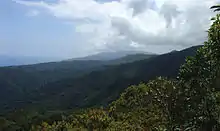
Forestland covers 54.37% or 579,819 hectares (1,432,760 acres) of Isabela's total land area of which 62% is protected forest and 38% is production forest. The best quality of timber resources in the Philippines are found in Isabela's forest. Isabela's vast forest resources are now being ecologically managed to effect sustainable forest-based resource not only for the wood working industry but to secure a balanced ecosystem. The woodwork industry continues to operate under a regulated system, particularly the making of furniture using indigenous materials.
Fisheries
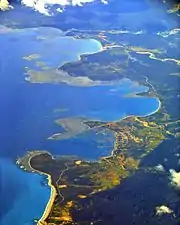
Isabela has a fertile fishing ground on the Pacific Coast. The Magat Dam reservoir is utilized for fish cage operations for tilapia production for domestic markets. Another thriving industry in the province is aquaculture, sustained by inland fishing through 1,108 hectares of developed freshwater fishponds and 450 hectares of fish cage culture at Magat Dam Reservoir. Rich marine resources could be found in Isabela's coastal seaboard municipalities of Maconacon, Divilacan, Palanan, and Dinapigue.
Mineral and energy
Large deposits of copper, gold, zinc and chromite, manganese and nickel have been found in Isabela. It also has extensive deposits of non-metallic minerals such as limestone, clay, marbles, guano, sand and gravel, and boulders. Indigenous energy sources such as natural gas and hydroelectric capabilities have been found to be abundant in the valley. Many of its mineral reserves have yet to be fully tapped.
Power
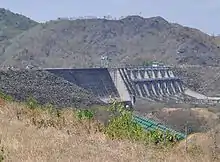
Solar and biomass power plants in the city of Cauayan and in the town of Alicia have started operating in 2015 to supplement the region's high energy demand. The online solar power plant in Cauayan City is capable of supplying at least 20 megawatts while the biomass power plant in Alicia can produce another 20 megawatts. Both systems provide clean and renewable energy. The P2 billion power facility established by the Isabela Biomass Energy Corporation (IBEC) was built to augment power supply in the Cagayan Valley region. The use of biomass as fuel makes the power plant carbon neutral and sustainable. This biomass power facility is the first in the region and is designed to provide economical source of energy as well as job opportunities to residents of the host town/city.
On May 27, 2015, the service contract of the largest solar PV power plant in the country has been approved by the Department of Energy (DOE). The P7-billion worth 100 MW Solar PV project in the city of Ilagan is designed to reduce the current shortage of electricity that causes regular blackouts that results to industry closures as well as inconvenience to the consumers. The solar power facility will be constructed at a 100-hectare land at Barangay Cabannungan, several kilometers away from the city proper.
Transportation
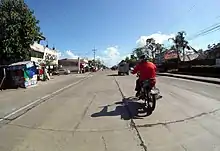
Isabela is accessible by all means of transportation. Almost 180-kilometers of the Pan-Philippine Highway pass through the different towns and cities of the province. Several bus companies offer daily trips to different routes like Manila, Dagupan, Baguio, Ilocos, and vice versa. Public utility vans and small-time bus operators ply daily trips from Tuguegarao in Cagayan to Santiago City vice versa, while jeepneys and tricycles are commonly used as the basic mode of transportation within the province's jurisdiction.
Ilagan-Divilacan Road
The construction of an 82-kilometer route across the Sierra Madre National Park is intended to improve access to the province's three coastal communities. The project's authorized budget contract, worth P1.5 billion, will traverse across the foothills of the Northern Sierra Madre mountain ranges, which cover 359,486 hectares. The idea is to rehabilitate an ancient logging route that was utilized until the 1990s by a defunct logging firm. It will begin in Barangay Sindon Bayabo in Ilagan City and end at Barangay Dicatian in Divilacan's seaside town. The project is scheduled to conclude in 2021.[50][51]
The secluded coastal settlements of Divilacan, Palanan, and Maconacon are frequently accessible only by boat or plane, making them difficult to reach at times of emergencies and calamities. There are no highways connecting Ilagan's capital city to the coastal districts, denying locals access to basic commodities and social services such as health care. Once completed, the route is projected to bolster coastal economies, citing Divilacan's 119-hectare beach and freshwater areas that have attracted tourists. Resolution No. 11 of the Protected Area Management Board (PAMB) reclassifies areas of the Sierra Madre as a special-use zone. Additionally, the Agta and Dumagat communities in the vicinity have signed a memorandum of understanding with the provincial administration expressing their support for the road project. At least 1,800 Agta and Dumagat have made their homes in park areas. However, the road's impact on the protected forest has upset neighbors, who believe the project will harm the region's woods and ecosystems. The project has been delayed in recent years due to worries about the road's possible environmental impact. The Cagayan Valley Regional Development Council required that the road's proponents conduct a comprehensive analysis of the road's impact on the area's biodiversity.[52]
Airports and sea ports
There are three airports in the province. The Cauayan Airport is the primary airport in the province serving a trip to Manila, Palanan, and Maconacon. The other two are the Palanan Airport in Palanan and Maconacon Airport in Maconacon. The country's leading passenger airline Cebu Pacific services the Cauayan-Manila-Cauayan Route. Light planes operated by Cyclone Airways and WCC Aviation's Sky Pasada Have flights from Cauayan Domestic Airport to the community airports in Palanan and Maconacon. The province has two minor seaports, the Divilacan Port and Palanan Port in the coastal towns of Divilacan and Palanan. The trade going to the ports comes primarily from major seaports in Cagayan such as Port of Aparri in Aparri, Cagayan, and Port of San Vicente and Port Irene, both in Santa Ana, Cagayan. The other two airstrips are found in Divilacan, and in Magat River Management Project Site.
Education
Isabela is one of the primary centers of education in the Cagayan Valley Region. There are several public and private educational institutions, the most notable being the Isabela State University, a government-owned and controlled public university. Its main campus is located in Echague and satellite campuses in Cauayan City, Ilagan City, Angadanan, Cabagan, Jones, Palanan (extension), Roxas, San Mariano, San Mateo and Santiago City (extension).
Colleges and universities
Among the most notable higher educational institutions found in the province of Isabela are the following:
- AMA Computer College (City of Santiago Campus)
- Cagayan Valley Computer and Information Technology College, Inc. (City of Santiago Campus)
- East Asia International System College (City of Cauayan Campus)
- Honorato Guzman Baquiran College (HGB College; Tumauini Campus)
- International Technological Institute of Arts and Tourism (City of Ilagan Campus)
- Isabela State University (Angadanan Campus)
- Isabela State University (Echague; Main Campus)
- Isabela State University (Cabagan Campus)
- Isabela State University (City of Cauayan Campus)
- Isabela State University (Jones Campus)
- Isabela State University (City of Ilagan Campus)
- Isabela State University (Roxas Campus)
- Isabela State University (San Mariano Campus)
- Isabela State University (San Mateo Campus)
- Isabela State University (Palanan Extension Campus)
- Isabela State University (City of Santiago Extension Campus)
- Isabela College of Arts and Technology (City of Cauayan Campus)
- Mallig Plains Colleges (Mallig Campus)
- National Police College Regional Training School (City of Cauayan Campus)
- Northeastern College (City of Santiago Campus)
- Northeast Luzon Adventist College (Alicia Campus)
- Our Lady of the Pillar College (City of Cauayan Campus)
- Our Lady of the Pillar College (San Manuel Campus)
- La Patria College (City of Santiago Campus)
- Philippine Normal University (Alicia, Isabela Campus)
- Saint Clare College of Region 2 (City of Cauayan Campus)
- Saint Ferdinand College (Cabagan Satellite Campus)
- Saint Ferdinand College (City of Ilagan; Main Campus)
- Santiago City Colleges
- Santiago City Polytechnic College
- STI College (City of Cauayan Campus)
- Technical Education and Skills Development Authority (City of Ilagan; TESDA Accredited Competency Assessment Center)
- University of La Salette (City of Santiago Campus)
- University of Perpetual Help System (City of Cauayan, Isabela Campus)
Tourism
Since the early 2000s, tourism has become an income-generating industry for Isabela. New hotels and resorts have opened, mostly in the cities of Ilagan, Cauayan and Santiago, and the towns of Tumauini, Gamu, Roxas, Alicia, Burgos, Ramon, San Mariano and Cordon. Top tourist attractions are the centuries-old churches; Magat Dam Tourism Complex, which houses Southeast Asia's biggest dam; Santa Victoria Caves, Pinzal Falls and Ilagan Sanctuary at Fuyot National Park; the white sand beaches in the coastal municipalities of Maconacon, Divilacan, Palanan, Dinapigue and islands of coastal Isabela; the world's biggest wooden lounge chair or butaka in Ilagan City; and various festivals and fiestas, including the Bambanti Festival annually celebrated every February, and the commemoration of the birth of the province during Isabela Day every May.
Places of interest
| Tourist attraction | Location |
|---|---|
| Abuan River | Ilagan City |
| Aguinaldo Shrine — Historic capture AND heroism of General Emilio Aguinaldo | Palanan |
| Balai na Ilagan | Ilagan City |
| Balay Segundo Museum | Ramon |
| Balay na Santiago | Santiago City |
| Bonifacio Park | Ilagan City |
| Bonsai Park | Dinapigue |
| Borubor Falls | Roxas |
| Burmurbur Falls | Ilagan City |
| Camp Samal — "Haven of Scouts" | Tumauini |
| Camp Vizcarra | Ramon |
| Crocodile Watching (Crocodylus mindorensis) | San Mariano |
| Department of Agriculture - Cagayan Valley Research Center Agro Eco-Tourism Farm | Ilagan City |
| Desert Island | Divilacan |
| Dibulo Falls | Dinapigue |
| Dicotcotan Beach | Palanan |
| Dilaknadanum — is the home Agta people, a minority group on the coast of Isabela. Features forests, beaches, rivers and small farmsteads uprivers. | Palanan |
| Dimanek Falls | Palanan—San Mariano boundary ridge |
| Dinapigue Sea Wall | Dinapigue |
| Hacienda De San Luis | Cauayan |
| Hanging Bridge | Maconacon |
| Honeymoon Island | Divilacan |
| Ilagan Sanctuary | Ilagan City |
| Ilagan Japanese Tunnel | Ilagan City |
| Isabela Museum and Library | Ilagan City |
| La Salette Shrine — located in Balintocatoc Hills, contains life-sized statues of religious icons. | Santiago City |
| Maconacon Falls | Maconacon |
| Magat High Rise Dam — Asia’s biggest dam project at the time of its construction. It serves the primary function of power generation and irrigation. Its reservoir area of 4,450 hectares has a great potential for water-based recreation like fishing, boating and water skiing, among others. | Ramon |
| Mororan | Tumauini |
| Museo de Pattaraday | Santiago City |
| Obelisk | Jones |
| Pinzal Falls | Ilagan City |
| Punta Amelita Resort | Cordon |
| Queen Isabela II Monument and Park | Ilagan City (in front of the Isabela Provincial Capitol) |
| Sierra Madre Natural Forest Park | Isabela's eastern coast |
| Sinavulluan Caves | Tumauini |
| Spring Garden Resort | Santiago City |
| Santa Maria Triangular Park | Santa Maria |
| Santa Victoria Caves | Ilagan City |
| Villa Diana Resort | Cordon |
| Water Impounding Dam | Roxas |
| Waterworld Grand Resort | Ramon |
| White Sand Beaches — Typical of coastal areas along the Sierra Madre mountains of Cagayan Valley. | Dinapigue, Palanan, and Divilacan coastal towns |
| World's Largest Butaka — It is 11 feet 4 inches high, 20 feet 8 inches long, and 9 feet 7 inches wide. It weighs 2,368 kilos and was constructed by 25 workers in 29 days. | Ilagan City |
Churches





- San Pablo Church in San Pablo, the oldest town of Isabela founded by Padre de Santo Tomas on Nov. 30, 1646 (about 210 years before Isabela was made a province). Its six-level bell tower including the circular apex is made of adobe. It is said to be the oldest in Isabela and the tallest in Cagayan Valley.
- Saint Rose of Lima Church in Gamu is known for its Spanish architectural design. Built in 1726 during the Spanish time, the church façade was made of layered bricks and stones dating back during the 17th century and considered a pilgrimage church because of its antiquity. The feast of their patron, Saint Rose of Lima is celebrated every 23 August.
- Parish Church of St. Mathias in Tumauini was first built of light materials by Fray Francisco Muńez, O.P., and dedicated to Patron Saint Matthias, 1707. Separated from Cabagan and became regular parish, 1751. The church of stone with a unique cylindrical bell tower. The only of its kind in the Philippines was constructed by Father Domingo Forto in 1783 and completed, 1805. The town became the capital of Isabela for a short time in the 1890s. It is an ultra-baroque church unique for its extensive use of baked clay both for wall finishing and ornamentation and bears Chinese ancestry. Partly damage during World War II and repaired into its original form by the faithful of Tumauini. This church was declared as a National Cultural Treasure on 24 February 1989.
- Our Lady of Atocha in Alicia was originally built by the Spaniards in the 18th century. Passing by Angadanan on 12 February 1805, Fr. Manuel Mora, OP wrote that "Angadanan has a convent of bricks, though not totally finished. Its church is timber, wood, and bamboo. The number of inhabitants is 791." The church and convent as seen today in the town of Alicia, was built by Fr. Tomas Calderon, OP and inaugurated in 1849, with Fr. Francisco Gainza, OP, then vicar of Carig (now Santiago City). The church was dedicated to the Nuestra Señora de Atocha, more popularly known today as Our Lady of Atocha. The church is known for its antique Castilian architectural design and can be found along the Maharlika Highway and is accessible by land transport.
- Our Lady of the Pillar Parish Church in Cauayan was constructed by Fray Juan Prieto with the first class materials with galvanized roofing and a ceiling of bricks, dedicated to Nuestra Señora del Pilar. It had a tower which was later destroyed by a violent earthquake. Now, only the façade of the Cauayan Church remains in its original form. The original belfry is in ruins while a new nave and belfry was constructed and like the St. Mathias Church in the town of Tumauini, the facade has much interesting bas relief and portions of the bricks have numbers and symbols etched on it.
- Saint Ferdinand Parish Church (Ilagan City) — This church can't be seen on the highways or the main national road as it was located in the center of the city of Ilagan. The church features very high ceilings and walls made of bricks. It was around 1696 and 1700 that Fr. Miguel Matos, OP, built the church of stone and bricks. A typhoon in 1866 destroyed the roof of the church. Desiring to make the church bigger, Fr. Pablo Almazan, OP, demolished the solid walls of the church, which, unfortunately, was never built. The walls of the church today are of modern make. It is known to house one of the oldest bells in the region. The church is dedicated to the patron saint of the Diocese of Ilagan, San Fernando.
- National Shrine of Our Lady of the Visitation of Guibang is located in town of Gamu, frequented by travelers passing by the Maharlika Highway. It comes alive every year on the month July when religious pilgrims visit to offer prayers during its feast day. The image of the Our Lady of the Visitation was canonically crowned by the Most Rev. Carmine Pocco, Papal Nuncio to the Philippines on May 26, 1973, at the former St. Ferdinand Cathedral (now St. Ferdinand Parish Church) in Ilagan City. The Catholic Bishops Conference of the Philippines at its 52nd Annual Bishop's Meeting held in Tagaytay on January 24–26, 1986 have approved the petition of Miguel Purugganan, former Bishop of the Diocese of Ilagan for the Church of Our Lady of the Visitation of Guibang to be called a National Shrine.
- Saint James the Apostle Parish Church (Santiago City)
- Poor Saint Clare Monastery (Gamu)
- Cathedral of Saint Michael the Archangel (Gamu)
- Our Lady of La Salette Parish Church (Roxas)
- Saint Joseph the Worker Parish Church (Echague)
- San Isidro Labrador Parish Church (San Isidro)
- San Roque Parish Church (The only Parish Church in the province that entrusted in the Missionaries of Our Lady of La Salette) (Ramon)
Festivals
| Festival | City/town | Notes |
|---|---|---|
| Baka Festival | San Pablo | A survey revealing quite number of ranches in San Pablo led to the establishment of the Baka Festival. Held every January 15, it aims to promote the local cattle industry. The festival also showcases cowboys of San Pablo displaying skills reminiscent of the American Wild West. |
| Balatong Festival | San Mateo | In San Mateo, mungo beans are packed with economic potential that it is referred to as "black gold". In previous years, the annual town fiesta promoted duck-related products during the Pato Festival. |
| Bambanti Festival | Province of Isabela | Celebrated annually by the entire province to honor the province's bountiful harvest and its emerging agro-industrial prowess. The festivity showcases the scarecrow dancing spectacles and agricultural booths. The municipalities and cities exhibit their respective culture, beliefs, traditions, origins and products. Annually, the event can drew at least 250,000 crowds all over the Cagayan Valley region, the biggest in the history of annual festivities in the region. It has become Isabela's showcase of its rich cultural heritage and pristine natural beauty. Bambanti is an iluko word for "scarecrow". |
| Binallay Festival | Ilagan City | Ilagueños have made the binallay a symbol of the noble characteristics they aspire to have. These include being masipag (hardworking), matiyaga (patient), matalino (intelligent), and makadiyos (God fearing). According to them, they are patient because the process of preparing binallay is tedious and involves steaming the rice cake twice, hardworking because it is difficult to prepare the rice cake (the glutinous grains are ground the traditional way, with a stone mill), intelligent because it requires a special technique to peel the wrapper off so that none of the cake is wasted and God fearing because it is a delicacy associated with the Holy Week. They regard the white cake as a representation of the body of Christ and the laro as his blood. As part of their penitence during Holy Week, Binallay is the only food that Ilagueños eat. Every May, their signature product takes center stage twice, once during the festival itself and during the Isabela Day celebrations earlier in the month when it usually has a wider audience. |
| Binnadangan Festival | Roxas | A yearly celebration of Pagay Festival (Palay Festival) held every July 4. The Festival was popularly known as the Araw ng Roxas Celebration but it was declared formally as Pagay Festival during the reign of Mayor Benedict Calderon. It is celebrated because of the rich agricultural bounty of Roxas, being one of the towns that produce large stocks of rice. The festival features a parade mostly of politicians and participating schools from different parts of Roxas, kuliglig contest and cooking of the biggest rice cake that was also featured in the national television. Major events include a Street Dance Competition from different schools and Palarong Bayan. Due to a conflict in the name of the festival, by which the town of Alicia celebrates the same. It was changed to Binnadangan Festival by then Mayor Harry Soller. The Binnadangan comes from an Ilocano word meaning bayanihan and was also derived from the former name of the town during the 1600s. The festival ends with a long Pyromusical. |
| Dikit Festival | Aurora | Known for being an agricultural municipality, Aurora annually celebrates its Dikit Festival every 28th to 30 April. Dikit is an Ilocano term for "glutinous rice". The festival is celebrated to showcase this delicacy and its by-products which are bibingka, muriecos, inangit, tupig, kalamay and tinudok, among others. Farmers in Aurora plant this glutinous rice served to guests during special occasions. |
| Gakit Festival | Angadanan | An annual festival held at the Cagayan River. Participants of the festival offer fruits, vegetables, poultry, and livestock as thanksgiving for their abundant bounty. The practice also reminds Angadanians of their tradition of planting crops and raising poultry in their own backyards for their own consumption. The Gakit Festival also aims to show Angadanians that progress can only be achieved if they are united as one. A key detail of the festival is the hand-made bamboo rafts which are used by the participants. Each bamboo pole, if alone, has no value. It cannot float reliably on a river nor can it be used to transport anything. But if many bamboo poles are tied together as one, it can be made into a raft which can float and sail on calm or rough waters while transporting people and products. |
| Gawagaway-yan Festival | Cauayan City | The City Fiesta and the Feast of Our lady of the Pillar are celebrated annually on April 10–13 and October 10–12 respectively. Since its conversion into a component city on March 30, 2001, the City Government started to celebrate its founding anniversary with the conduct of "Gawagaway-yan Festival" aimed to preserve the rich cultural heritage of the city. It is highlighted by street dancing, beauty contest, trade fair, cultural parade, parlor games, free concert, band exhibition and other variety shows performed by local and Manila-based talents as well. |
| Isabela Day | Province of Isabela | Anniversary of the establishment of the civil government of Isabela in honor of Queen Isabella II of Spain. Activities like agro-industrial trade and tourism fairs, parades, sports events are conducted to entertain visitors. Also, one of the highlights of the celebration is the Miss Isabela, an extravagant colorful pageant featuring the candidates from each town/city of the province who exemplify Isabela's youth and vibrancy. A grand fusion of fashion, music and dance with particular focus on Isabela's tourism attractions and its leader. |
| Kankanen Festival | Cabatuan | Celebrated in Cabatuan, showcasing native delicacies made of glutinous rice. Mayor Alma Dayrit and the Rural Improvement Club started this annual tradition in 2003 and done on the Foundation Day rites of every year. |
| Mammangui Festival | Ilagan City | Celebrated by Ilagueño farmers as a thanksgiving activity for a bountiful harvest, Mammangui is an Ybanag word which means to harvest corn, the primary crop in the city. Since the assumption in office of Mayor Josemarie L. Diaz, Mammangui Festival was proclaimed as the official festivity of the city. During the celebration, different activities such as parlor games, cultural and trade fairs, colorful street dance, cook fest, sports events, cheerdance competitions, float parade and many others are conducted by the city government to showcase the past to present day transition of Ilagan's rich tradition and cultural heritage. Highlights of the celebration are the annual beauty pageants namely Little Miss Mammangui, Miss Gay Mammangui and the Miss Mammangui, which is one of the most prestigious of its kind in the valley and a free concert featuring local celebrities. It is annually celebrated every 29–31 May. |
| Mangi Festival | Tumauini | Corn (Zea mays) was one of the plants that came aboard the Spanish galleons to become one of the primary crops of the Philippines. The late National Artist for Dance, Ramon Obusan traced the origins of a traditional dance inspired by the crop to Tumauini. Thus, a corn-inspired festival seemed especially appropriate for Tumauini. |
| Nateng Festival | Mallig | |
| Cariada Festival | San Manuel | |
| Nuang Festival | San Agustin | The carabao (Bubalus Bubalis Carabanesis), which remains a farmer's indispensable helpmate in the fields, is honoured in the Nuang Festival of San Agustin as are the products the carabao enables farmers to produce. The town boasts of over 300 heads and farmers bring them over to the poblacion (town center) for the festival. To get the cattle there, they either guide the animals onto the ferry and keep them quiet for the short river crossing or find the shallowest point of the river, take off their clothes then lead them across. San Agustin supplies carabao milk to other towns where carabao milk candy is produced. The festival also serves as a venue for promoting other major products such as maize (Zea mays) and bananas (Musa paradisiaca L.). |
| Pagay Festival | Alicia | Held annually every September 28 in conjunction with the founding anniversary of the town of Alicia. It used to be called Alicia Town Festival, but was redefined and renamed to Pagay Festival in 2010 by Mayor Cecilia Claire N. Reyes. The festival aims to uphold the town's cultural identity and heritage and to promote the municipality's primary agricultural product called, pagay (Ilocano word for rice) - the municipality's major livelihood economy and trade mark. The festival is widely participated by the community which features various competitions (e.g., rice planting, harvesting, and cooking among others), street dance showdown, beauty pageant (Mutya ng Alicia), battle of the bands, and exhibits. However, the Pagay Parade is the main highlight of the festival that features decorated carabaos, various rice crop floats, and people marching with colorful costumes. |
| Pansi Festival | Cabagan | Pansi Festival is the official festivity of Cabagan.Pansi is an Ybanag word for pansit, a noodle dish topped with chopped karajay or lechon kawali in Tagalog. The town became noted for its well-known local product, the "Pansit Cabagan". |
| Pattaraday Festival | Santiago City | From pattaraday, an Ybanag word for "unity", the festival is celebrated in the city of Santiago to honor its founding anniversary, and the unity of the ethnolinguistic groups that have merged in the city to make it the melting pot of culture of Region II and contributed to the city's progress and development-unity in action. Highlighted with the presentation of the Comedia – a moro-moro dance made famous by the Spaniards to stress the power of Christian Religion over the Moorish non-believers; other activities include beauty pageant, grand batalla presentations and a grand street dancing parade and exhibition with performers from other cities, provinces and regions. |
| Pinilisa Festival | Jones | |
| Sabutan Festival | Palanan | Held every March in Palanan, the festival is named after the local name for pandan (Pandanus tectorius) which is plentiful in the town. The people of Palanan are fine craftsmen who weave dyed and natural colored strips into a variety of bags, hats, and placemats, among other items that have both traditional and contemporary designs. For the festival, the sabutan products are not only sold, these are also used as a theme and are fashioned into costumes and décor. |
| Sinag-Banga Festival | San Isidro | |
| Balamban Dance Festival | Santiago City | On the year 2014, a new festival was conceptualized by the city government to celebrate Santiago's cityhood anniversary. Balamban which means butterfly is a cultural dance of lowland Christians that originated in Santiago City. The dance depicts the graceful movement and fluttering of butterflies that throng Dariuk Hills' scented gardens. It is usually danced during wedding celebrations in Santiago. |
Notable personalities
- General Mateo Noriel Luga - (Tumauini, Isabela) - War veteran/revolutionist
- Florence Finch — (Santiago, Isabela) — Filipino-American member of the World War II resistance against the Japanese occupation of the Philippines.
- Heherson Alvarez — (Santiago, Isabela) - former Senator[53]
- Grace Padaca — former Governor of Isabela and former Commissioner of the Commission on Elections, recipient of the Ramon Magsaysay Award for Public Service in 2008.
- Bishop Miguel Purugganan - (Ilagan, Isabela) - Bishop of the Roman Catholic Diocese of Ilagan who protested the Human rights abuses of the Marcos dictatorship, and is honored at the Bantayog ng mga Bayani[54]
- Freddie Aguilar — (Santo Tomas, Isabela) - Singer/composer
- Jejomar Binay — (Cabagan, Isabela) - 13th Vice President of the Republic of the Philippines
- Ruthlane Uy Asmundson — (Gamu, Isabela) - Mayor of Davis, California, USA
- Silvestre Bello III — (Ilagan, Isabela) - Secretary of the Department of Labor and Employment
- Gilbert Teodoro — former secretary of the Department of National Defense
- Mutya Datul — (Santa Maria, Isabela) - Miss Supranational 2013 and Binibining Pilipinas - Supranational 2013
- Rogemar Menor — (Roxas, Isabela) - PBA Player
- Ricky Calimag — (Echague, Isabela) — PBA player
- Val Acuña - (Ilagan, Isabela) - Professional Basketball player from Alab Pilipinas of the ASEAN Basketball League
- Mark Clemence Telan — PBA Player
Notes
- (Ilocano: Probinsia ti Isabela; Ibanag: Provinsia na Isabela; Gaddang: Probinsia na Isabela; Tagalog: Lalawigan ng Isabela)
- "Isabela, Sentro ng AGRIKultura". Facebook.com. Isabela PIO. Retrieved 31 May 2018.
- "List of Provinces". PSGC Interactive. Makati City, Philippines: National Statistical Coordination Board. Archived from the original on 11 January 2013. Retrieved 8 January 2014.
- U.S. Corps of Engineers (1953). "Ilagan (topography map)". University of Texas in Austin Library. Retrieved on 2014-09-28.
- Census of Population (2020). "Region II (Cagayan Valley)". Total Population by Province, City, Municipality and Barangay. PSA. Retrieved 8 July 2021.
- "POPULATION PROJECTIONS BY REGION, PROVINCE, CITIES AND MUNICIPALITIES, 2020-2025". www.doh.gov.ph. Department of Health. August 27, 2020. Retrieved October 16, 2020.
- "Isabela, top producer of corn". Bureau of Agricultural Statistics. Department of Agriculture (Philippines). Retrieved 27 February 2013.
- "A Review of the Agriculture Sector in Cagayan Valley". Philippine Statistical Authority | Government Website. Retrieved April 1, 2021.
{{cite web}}: CS1 maint: url-status (link) - "Cagayan Valley remains number 1 corn producer, 2nd in rice | RDC2". Retrieved 2021-04-01.
- "| Official Website of the Province of Isabela - The Province of Isabela Reigns... by chance or by choice?". provinceofisabela.ph. Retrieved 2021-04-01.
- "Isabela,10th richest province in the Philippines in 2011". Inquirer PH. Inquirer. 19 October 2014. Retrieved 19 October 2014.
- "Fastest Growing Cities in Cagayan Valley" (PDF). NEDA.GOV.PH. Retrieved April 1, 2021.
{{cite web}}: CS1 maint: url-status (link) - "Brief History of Isabela". Fly Philippines. Retrieved 18 June 2011.
- Act No. 210, passed August 24, 1901.
- Ropero, Gillan (2020-11-15). "Cagayan, Isabela residents warned of Magat Dam water release: NIA". ABS-CBN News. Retrieved 2020-11-16.
- Delina, Laurence L. (2020-07-01). "Indigenous environmental defenders and the legacy of Macli-ing Dulag: Anti-dam dissent, assassinations, and protests in the making of Philippine energyscape". Energy Research & Social Science. 65: 101463. doi:10.1016/j.erss.2020.101463. ISSN 2214-6296.
- "Magat River Multipurpose Project (02)". World Bank. Retrieved 2020-11-16.
- Republic of the Philippines, Commission on Elections (26 May 1995). "Resolution No. 2796 ". Manila Standard Today. Retrieved 19 June 2011.
- Robles, Chan. "Republic Act No. 7891 - An Act Dividing the Province of Isabela Into Two Provinces Namely: Isabela del Norte and Isabela del Sur". Philippine Laws, Statutes & Codes, and Republic Acts. Chan Robles Virtual Law Library. Retrieved 19 June 2011.
- Catindig, Raymund (28 February 2011). "Marcos Mania still alive in Isabela 25 years after EDSA". Valley Journal News Online. Archived from the original on 14 May 2011. Retrieved 19 June 2011.
- Isabela's Ilagan now a component city Archived 2015-09-25 at the Wayback Machine Philippine Star. Retrieved 08-15-2012
- Ilagan now 4th city in Cagayan Valley Philippine Daily Inquirer. Retrieved 08-15-2012
- [Ilagan Kicks Off Cityhood Bid Manila Bulletin http://www.mb.com.ph/articles/368552/ilagan-kicks-off-cityhood-bid. Retrieved 2012-08-11.
{{cite web}}: Missing or empty|title=(help) ] Manila Bulletin. Retrieved 08-11-2012 - "Province: Isabela (province)". PSGC Interactive. Quezon City, Philippines: Philippine Statistics Authority. Retrieved 8 January 2016.
- gmanews.tv/story, Isabela gov sees big job ahead vs illegal logging
- iWitness: Si GOB at ang mga BUGADOR, 08/25/2008
- "Mount Cresta, Divilacan, Cagayan Valley, Philippines". Google Maps. Retrieved on 2014-09-28.
- "House Bill No. 4692 - An act reapportioning the current four legislative district of the province of Isabela to six legislative districts" (PDF). www.congress.gov.ph. House of Representatives, Republic of the Philippines. December 14, 2016. Retrieved 27 February 2017.
- Census of Population (2015). "Region II (Cagayan Valley)". Total Population by Province, City, Municipality and Barangay. PSA. Retrieved 20 June 2016.
- "Republic Act No. 10169; An Act Converting the Municipality of Ilagan in the Province of Isabela into a Component City to be Known as the City of Ilagan" (PDF). Senate of the Philippines. 21 June 2012. Retrieved 16 January 2016.
- Ilagan cityhood gets Senate nod Archived 2016-06-05 at the Wayback Machine Philippine Star. Retrieved April 11, 2012.
- Census of Population and Housing (2010). "Region II (Cagayan Valley)". Total Population by Province, City, Municipality and Barangay. NSO. Retrieved 29 June 2016.
- "Republic Act No. 11080 - An act reapportioning the second largest province of the Philippines into six legislative districts". Inquirer PH. Inquirer.Net. 27 September 2018. Retrieved 29 September 2018.
- "Republic Act No. 11080". Inquirer PH. Inquirer.Net. 27 September 2018. Retrieved 29 September 2018.
- "AN ACT REAPPORTIONING THE PROVINCE OF ISABELA INTO SIX (6) LEGISLATIVE DISTRICTS" (PDF). Official Gazette of the Republic of the Philippines. July 23, 2018. Retrieved October 8, 2021.
{{cite web}}: CS1 maint: url-status (link) - Censuses of Population (1903–2007). "Region II (Cagayan Valley)". Table 1. Population Enumerated in Various Censuses by Province/Highly Urbanized City: 1903 to 2007. NSO.
- "Philippines Census Of Population of all LGUs 1903-2007". archive.org. Philippine Statistics Authority. Retrieved 14 February 2017.
- "Poverty incidence (PI):". Philippine Statistics Authority. Retrieved 28 December 2020.
- https://psa.gov.ph/sites/default/files/NSCB_LocalPovertyPhilippines_0.pdf; publication date: 29 November 2005; publisher: Philippine Statistics Authority.
- https://psa.gov.ph/sites/default/files/2009%20Poverty%20Statistics.pdf; publication date: 8 February 2011; publisher: Philippine Statistics Authority.
- https://psa.gov.ph/sites/default/files/Table%202.%20%20Annual%20Per%20Capita%20Poverty%20Threshold%2C%20Poverty%20Incidence%20and%20Magnitude%20of%20Poor%20Population%2C%20by%20Region%20and%20Province%20%20-%202006%2C%202009%2C%202012%20and%202015.xlsx; publication date: 27 August 2016; publisher: Philippine Statistics Authority.
- https://psa.gov.ph/sites/default/files/Table%202.%20%20Annual%20Per%20Capita%20Poverty%20Threshold%2C%20Poverty%20Incidence%20and%20Magnitude%20of%20Poor%20Population%2C%20by%20Region%20and%20Province%20%20-%202006%2C%202009%2C%202012%20and%202015.xlsx; publication date: 27 August 2016; publisher: Philippine Statistics Authority.
- https://psa.gov.ph/sites/default/files/Table%202.%20%20Annual%20Per%20Capita%20Poverty%20Threshold%2C%20Poverty%20Incidence%20and%20Magnitude%20of%20Poor%20Population%2C%20by%20Region%20and%20Province%20%20-%202006%2C%202009%2C%202012%20and%202015.xlsx; publication date: 27 August 2016; publisher: Philippine Statistics Authority.
- https://psa.gov.ph/sites/default/files/Table%202.%20%20Updated%20Annual%20Per%20Capita%20Poverty%20Threshold%2C%20Poverty%20Incidence%20and%20Magnitude%20of%20Poor%20Population%20with%20Measures%20of%20Precision%2C%20by%20Region%20and%20Province_2015%20and%202018.xlsx; publication date: 4 June 2020; publisher: Philippine Statistics Authority.
- "Isabela, Top 10 richest province in the Philippines in 2011". Inquirer PH. Inquirer. 19 October 2014. Retrieved 19 October 2014.
- "Isabela, the Regional Trade and Industrial Center of north-eastern Luzon". Inquirer PH. Inquirer. 19 October 2014. Retrieved 19 October 2014.
- Top 10 Highest earning Philippine province Nobert Bermosa website. Retrieved 06-17-2012.
- "Robinsons Place Santiago Grand Opening Invitation". Flickr. Retrieved 18 January 2014.
- "P3-M premyo ng Isabela bilang Best Corn Quality Awardee". Bombo Radyo. Archived from the original on 19 October 2013. Retrieved 19 October 2013.
- "P1.6-B Isabela road to open soon". The Manila Times. 2019-10-02. Retrieved 2021-09-04.
- "REGION II - CAGAYAN VALLEY : Upgrading of Ilagan-Divilacan Road | SubayBayan". subaybay-dev.dilg.gov.ph. Retrieved 2021-09-04.
- Martin, Victor. "P2-billion highway near Benham Rise to open before end of 2018". Philstar.com. Retrieved 2021-09-04.
- https://news.abs-cbn.com/spotlight/04/20/20/heherson-sonny-alvarez-keeper-of-the-flame
- "PURUGGANAN, Miguel Gatan". Bantayog ng mga Bayani. 2015-10-09. Retrieved 2020-09-04.
Further reading
- http://provinceofisabela.ph Official Website of the Province of Isabela. Retrieved October 3, 2014
- http://www.tourism.gov.ph/sitepages/FestivitiesList.aspx?festivityCode=292&monthCode=05. Retrieved October 8, 2014
- http://www.philstar.com/nation/2014/02/01/1285254/isabelas-bambanti-festival-lures-thousands Bambanti Festival. Retrieved October 8, 2014
- http://provinceofisabela.ph/index.php?option=com_content&view=article&id=168&catid=95. Retrieved October 8, 2014
- http://provinceofisabela.ph/index.php/tourism/festivals?showall=&limitstart=. Retrieved October 8, 2014
- https://web.archive.org/web/20141014040136/http://www.rogerswebpoint.com/historyofcabatuan.htm Retrieved October 8, 2014
- http://www.spcicdtourism.com/#!festival/ccp2 Retrieved October 10, 2014
- http://www.manilatimes.net/renewable-energy-plant-to-rise-in-isabela/172957/ Renewable energy plant to rise in Isabela. Retrieved June 15, 2015
- https://web.archive.org/web/20150630234413/http://news.pia.gov.ph/article/view/481433287402/p7-b-solar-power-plant-to-rise-in-isabela P7-B solar power plant to rise in Isabela. Retrieved June 15, 2015
- http://newsinfo.inquirer.net/742119/construction-of-p2-28-b-road-thru-sierra-madre-starts-amid-protests#ixzz3xK3EqC2O P2.28B road project for Ilagan-Divilacan Road Retrieved January 18, 2016
External links
 Media related to Isabela (province) at Wikimedia Commons
Media related to Isabela (province) at Wikimedia Commons Geographic data related to Isabela (province) at OpenStreetMap
Geographic data related to Isabela (province) at OpenStreetMap- Philippine Standard Geographic Code
